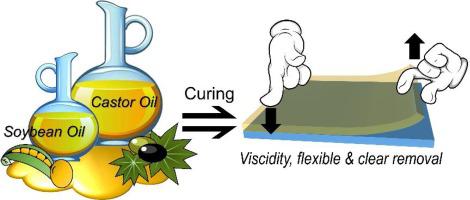Chinese Chemical Letters ( IF 9.4 ) Pub Date : 2020-06-10 , DOI: 10.1016/j.cclet.2020.06.015 Yu-Fei Lei , Xiao-Lin Wang , Bo-Wen Liu , Li Chen , Yu-Zhong Wang

|
A novel kind of fully bio-based PSAs were obtained through the curing reaction between two components derived from the plant oils: carboxyl-terminated polyricinoleate (PRA) from the castor oil and epoxidized soybean oil (ESO). The gel content, glass transition temperature (Tg), rheological behavior, tensile strength, creep resistance and 180° peel strength of the PSAs were feasibly tailored by adjusting the component ratio of ESO to PRA. At low cross-linking level, the PSAs behaved like a viscous liquid and did not possess enough cohesiveness to sustain the mechanical stress during peeling. The PSAs cross-linked at or near the optimal stoichiometric conditions displayed an adhesive (interfacial) failure between the substrate and the adhesive layer, which were associated with the lowest adhesion levels. The PSAs with the dosage amount of ESO ranging from 10∼20 wt% were tacky and flexible, which exhibited 180° peel strength ranging from 0.4∼2.3 N/cm; and could be easily removed without any residues on the adherend. The process for the preparation of the fully bio-based PSAs was environmentally friendly without using any organic solvent or other toxic chemical, herein showing the great potential as sustainable materials.
中文翻译:

衍生自羧基端基聚蓖麻油酸酯和环氧化大豆油的生物基可移动压敏胶
通过两种源自植物油的成分之间的固化反应,获得了一种新型的完全基于生物的PSA:来自蓖麻油的羧基封端的聚蓖麻油酸酯(PRA)和环氧化大豆油(ESO)。凝胶含量,玻璃化转变温度(T g),通过调节ESO与PRA的组分比,可以合理地调整PSA的流变行为,拉伸强度,抗蠕变性和180°剥离强度。在低交联水平下,PSA表现得像粘性液体,并且没有足够的内聚力来承受剥离过程中的机械应力。在最佳化学计量条件或接近最佳化学计量条件下交联的PSA显示出基材和粘合剂层之间的粘合(界面)破坏,这与最低的粘合水平有关。ESO用量为10〜20 wt%的PSA具有粘性和柔韧性,表现出180°的剥离强度,范围为0.4〜2.3 N / cm。而且很容易去除,在被粘物上没有任何残留物。





















































 京公网安备 11010802027423号
京公网安备 11010802027423号